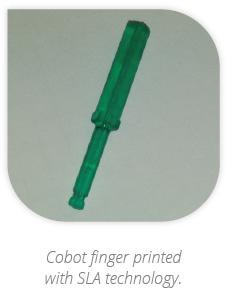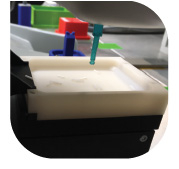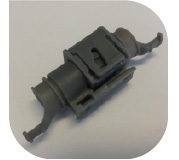Stereolithography (SLA) 3D Printing

How SLA 3D Printing Technology works
3D printing or additive manufacturing is the process of creating solid parts from three-dimensional models, by adding layer upon layer of material. There are many 3D printing technologies that build 3D structures and objects (e.g. laser melting, fused deposition modeling, electron beam melting, material jetting). The processes are slightly different and have their own unique advantage and disadvantages. For this post, we’re going to cover SLA print technology, which is what we use for desktop 3D printing at our Centr'Alp facility.
Stereolithography (SLA) 3D Printing
A printing machine called a stereolithography apparatus (SLA) converts liquid plastic into 3D models by using a UV laser to cure a photosensitive liquid resin into hardened plastic. For the printer to create a physical object from a digital model, it needs a readable software file which is created by exporting a 3D modeling program file usually into an STL file. Once inserted, the printer processes the file and generates information for each layer. Then the UV laser gets to work. There are right-side up SLA machines and inverted SLA machines. The only difference is where the components are placed within the device, such as the light source, build platform, and resin tank.
Here’s how it works
In a right-side up SLA printer, a build platform is lowered into a large tank containing the liquid resin, so only a thin layer of the resin is in between the platform and the bottom of the tank. The UV laser is directed through a transparent window at the bottom of the resin tank with mirror devices mounted on galvanometers, which are instruments used for measuring electric current. As the laser draws a cross section of the model, it also hardens the material. Once the layer is complete, it is raised from the bottom of the tank, and lowered once again as a new layer of resin is spreading. This process continues as the subsequent layers are traced out by the laser. Support structures are also built by the laser which need to be manually removed from the finished model.




3D printing is a process deployed in many industries to assist in the rapid prototyping of new designs and products. Small desktop 3D printers allow companies to make models, prototypes or other tools very quickly. Printing times vary depending on the size of the model and the resolution selected, but some objects can be completed in a few hours.
At Radiall, we’ve used SLA 3D printing for small parts, or parts with fine details, shapes or features. SLA is more accurate and allows for the creation of smoother surfaces. Using this technology, we’ve printed mostly models, and some small tool and robotic gripping fingers.


Printed parts of QuickFusio™
with SLA technology.


